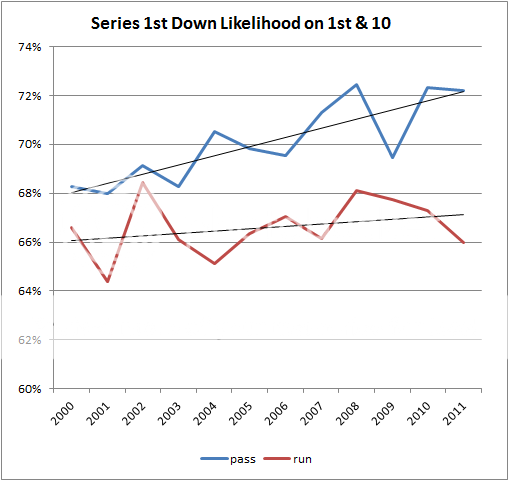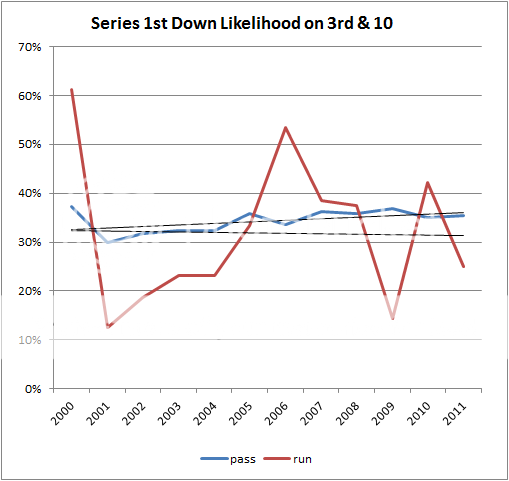Note: this is a companion article to last week's column at the Washington Post.
One of the common defenses of a run-heavy offense is that offenses need to make their third downs “manageable,” meaning short enough so that conversion is easier. The thinking goes that if an offense runs on either or both first and second down, it is relatively assured of shorter rather than longer distances on third down. At first look, this makes a lot of sense. After all, who wants to face third and long?
There are two problems with this argument. The first is that football is not a game of piling up first downs. The days of inching toward the goal line on 18-play drives are long gone if they ever existed at all. Football is, for the most part, a game of maximizing score differential, and the concept of Expected Points shows that NFL offenses are generally running too often on first and second down.
The second problem is that even if gaining a first down is the primary objective, running on first down is becoming a worse idea every year. The graph below shows that passing on first down leads to a conversion more often than running on first down. As usual, I limited the data to plays in ‘normal’ football situations, when the score is relatively close and time is not yet a factor at the end of either half.
Whatever the reason, it’s apparent that running to move the chains makes an offense less likely to convert. There are very good reasons for running and some situations do call for a run-heavy strategy mix, but it does not make an offense more likely to convert.
What if the first down pass falls incomplete? Should the offense run to more or less guarantee a more ‘manageable’ third down, or should it pass more often? The next graph shows conversion percentages on 2nd and 10.
Passing remains the more successful option, and every year it is becoming more successful.
Here’s where it gets a little more interesting. On third and 10, passing is no more successful than running at converting.
Teams run so infrequently in that situation that defenses are less prepared. This tells us offenses (and defenses) are choosing the two strategies in the correct proportion, at least as long as converting is the measure of ultimate utility. Why are offenses consistently correct on third down but off the mark on 1st and 2nd downs?
I think the answer is that the results of each strategy are immediately apparent to coaches and coordinators on third down but not on first or second down. The feedback is not a statistical abstraction like ‘future probability of conversion’ or Expected Points, but rather an instantly concrete result. Either the punting team is jogging onto the field or your offense just successfully moved the chains. It’s much easier to statistically, or even intuitively, find the optimum mix when the results are immediately apparent.
Running to Create a 'Manageable' 3rd Down Is Self-Defeating
By
Brian Burke
published on 10/15/2012
in
game theory,
research,
run-pass balance,
strategy
Subscribe to:
Post Comments (Atom)












It might be a problem on my end, but I can't see any of the graphs.
(It's on your end, Fred, the graphs are fine.)
Brian: I know you've done much more complicated and technical analyses, but this is one of your best articles. Insightful, simple, intuitive, interesting. That last graph on 3rd & 10 is great. It'll be hard for anyone to read this and dismiss it, but I'm sure coaches will find a way.
@ Alex
Making sound decisions based on mathematical models only helps you keeps your job as a coach if your team performs at or above the league average. Going w/ the flow allows for the use of age old excuses and a possible contract extention.
How many of the runs on 3rd and 10 are QBs scrambling for the 1st on a broken play? I'm not sure off hand how your data works, if those are counted as passing because that's what was called, or running because that's what happened. Seems that the number of called runs would be low enough that QB scrambles would mess with the data quite a bit.
I assume the error bars on the run on third-and-ten would be pretty big.
I'm trying to think about other things like what Dan noted - it's not as though teams are assigned to run or pass. It's a choice. It may simply be that choosing to run is a bad choice, but maybe teams that pass more are teams that have better quarterbacks and teams that run more are teams with bad quarterbacks. The connection between passing and success is interesting, and I'm fully prepared to accept the causal explanation - that coaches should run less - but causality doesn't fall out of these results automatically.
If teams were less conservative on 4th down, wouldn't that make running on 1st and 2nd down more productive?
I'll offer this counterpoint to the pass is better than run on 2nd & 10 or more: I would posit that a "safe" pass--in other words, a check-down/RB or WR screen/simple hook pattern by the TE etc. is as good of an option as a run, and maybe a better option than a "long" pass--in other words, anything past the sticks. (Understand, my idea would be any short pass where YAC are fairly normal--this gives the receiver a chance to make a play.) Now obviously, a completed pass or run past the sticks is the objective, and late in the game may be the "only" option that leads to winning. However, since Brian's graphs are for game theory purposes only, I'll stick with that.
I'll also agree with Brian's previous post on this topic, and the commenter above--the more downs, the more running is a good option because passing is more volatile.
3rd and 10 conversion is roughly 0.33. Naively, that means we'd expect a 'play everything like 3rd and long' approach would give a conversion rate of 0.7 for 1st and 10. Oddly, that's better than what the teams produced in the first half of the 2000s.
"One of the common defenses of a run-heavy offense is that offenses need to make their third downs “manageable,” meaning short enough so that conversion is easier."
After you led off with this, I was hoping to see some kind of 2nd or 3rd down conversion rate by yards, and a discussion of what (besides moving the chains on 2nd) a 'manageable' 3rd down looks like.
Why do people continue to try and apply saber-metrics to football? They simply don't work in any team performance sport. Teams are so completely different, and the minuscule sample size, make it so its almost completely useless to try and use saber-metrics to predict what and how they will perform. Its a completely different answer if I'm the Vikings with AP as my back and Ponder as my QB, versus if I was the old Colts, with Peyton Manning as my QB and Donald Brown as my back. Stop already.
Anonymous,
Sabermetrics helps tell you which way the wind is blowing. Of course, the situation is completely different for the Vikings and Manning-Colts. What sabermetrics is telling you is whether the wind is in your face or behind your back. In other words, the graphs here say that if you choose the run, you're going against the grain of probability. If you're the Vikings, you probably run anyway because you might be more effective running even when the other team expects it.
These graphs help us find the strategic equilibrium point between passing and running. Yes, it will vary team to team, but it is important to understand these things in the general case. If nothing else, it helps you understand how much lost potential the Vikings have because they can't exploit a passing game's expected effect.
Nice write up; Glad to have stumbled upon this site, will have to check back in more frequently. A few thoughts come to mind, having not thoroughly explored the site.
With regard to running versus passing on downs, I am wondering if people have established a Risk Premium that can be applied to running and passing. IOW, whats the reduction in Value of a given Play due to turnover (via interception or fumble) in Run vs. Pass, and how does that Value change on 1st, 2nd, 3d?
Another thought, I do believe this type of analysis is worthwhile, against the one commentor's opinion. Some exploitable patterns come up through stats and that's what we are after.
It can be helpful to your team if you evaluate your statistics to the league wide baseline. No question about it. That's basically how Options are traded.